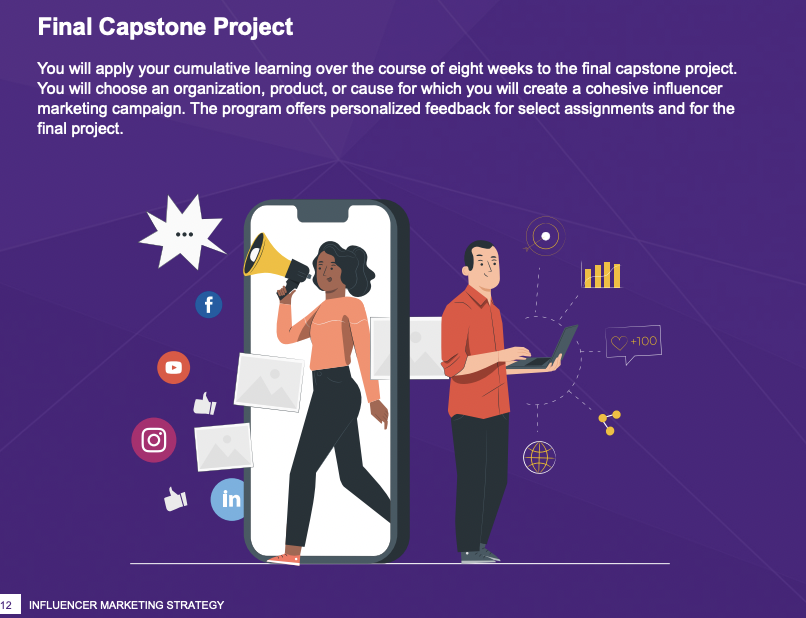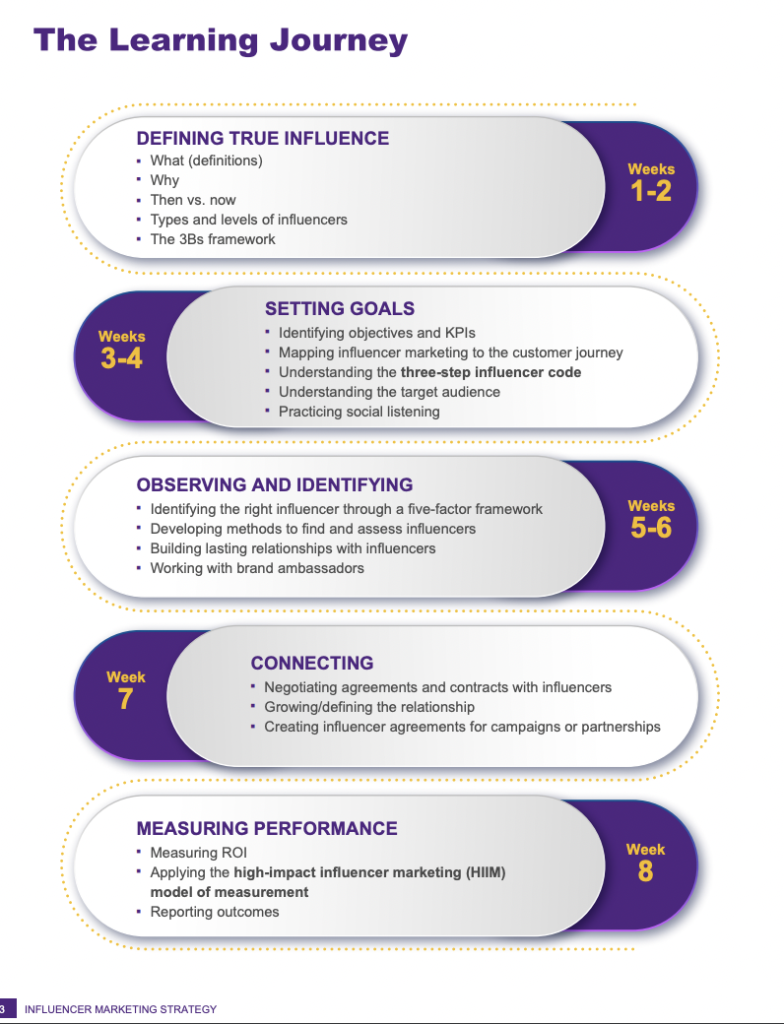
Students will get to create an influencer campaign in a final capstone project. Photo courtesy of the program brochure.
What are some examples of influencer marketing besides, say, the personalities selling shoes or going to restaurants on Instagram?
I actually think that companies that are doing it in the B2B space are doing it way better than any B2C companies. If you’ve ever downloaded a white paper or an e-book, watched a webinar, or if you’ve ever had to raise money for a company, then you are involved in influencer marketing. In terms of raising money, that’s all about your pedigree. Investors are looking at who else is invested in you. Business is a game, it’s a strategy, and I say this to students: If you have a challenge at work and you don’t know how to win this audience, bring it to the table. Let’s solve it. Let’s figure out an unconventional way to figure out how to influence that audience.
What will students will take away from the course?
We work through a framework in which every lecture and module builds upon itself. It starts at a very macro level where, first we just shift the way we think about it. Then move into the tactical ways of how to direct a marketing team on how to do it. We set up the drivers and more traditional marketing strategies that can either be augmented, enhanced or overhauled by using influence partners.
One of the big problems, with not just influencer marketing but all of marketing, is how do we measure? We as marketers have to understand what the CFO and the CEO are going to ask at the end of the day in terms of metrics. Instead of KPIs, I call it Planning to Measure. So, the course gets into some of the different ways that you can structure programs, plans and campaigns to measure quantitatively.

The program’s framework from the course brochure.
I’ve also created a framework that I think is really valuable. Yes, we’ve been taught and taught and taught that we need to quantify everything, and we do, and we should use data to support the argument. But there has to be a way to influence senior leadership on the value of a strategy campaign that is not as easily measured in a bunch of volume metrics. And that is through, and I hate to almost say it because it’s so fluffy, through storytelling. But there is a framework to do it.
Why do you think influencer marketing is growing so fast? Why do you believe it’s something companies and leaders need to start thinking about now?
I predict that in the next two to three years, we will see marketing change more than it has in the past 40 years. That’s just my prediction, but it’s based on a lot of studies and research on how fast things are changing. The consumer is now armed with everything. People can basically live in an ad-free world. The younger the audience, the more they do not trust traditional media, they don’t trust the brand itself, they don’t trust anything that even feels promotional.
So this idea that a social media content creator is an influencer, I think that’s going to erode as well. Because as soon as somebody feels like it was a pay-to-play, they’re discredited. We have to combat that and figure out who is really our audience? Where are they really going for information, and how do we reach them? Unless we want to compete on price all the time, how do we influence the audience?
There are various tactics for influence of different stakeholders and audiences. For example, think about ZICO Coconut Water, and how it built itself from scratch without a big budget. They went into a really tiny market, but a market that they felt was really influential, in New York City. But not just any neighborhood in New York City. They owned it on just specific tiny zip codes within this island of Manhattan. They went in and they literally put a field marketing team on the ground to just make friends with every store and studio and boutique in that neighborhood, and asked them to stock ZICO. So guess who the influencers were? They were every single bodega, convenience store, gym, fitness studio and clothing store. If you lived in the Upper West Side of Manhattan during that time, you saw ZICO at every single turn. And every distributor loved ZICO and they wanted to talk about it because they had real relationships.
But you can’t put that on a spreadsheet. So it’s a shift in thinking about who those partners could be.
What else do you think prospective leaders or executives should know?
Right now, I think we’re confusing influence with attention — attention, popularity, fame. Influence and attention are not the same thing. You need trust. In a nutshell, that’s the equation of the course: Influence is attention plus trust. It’s a pull, not a push. Once you understand that, it’s the most liberating way to think because then there is no opportunity that’s off the table. How to do that is what we cover in the course.
DON’T MISS “ALL MY EGGS IN ONE BASKET”: AN APPLICANT GOES BIG ON A LONG SHOT AND SCORES and AN UNCONVENTIONAL PATH TO LONDON BUSINESS SCHOOL: FROM WRITER TO EXECUTIVE VP





Questions about this article? Email us or leave a comment below.